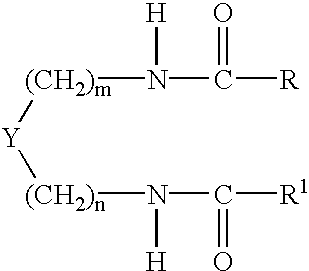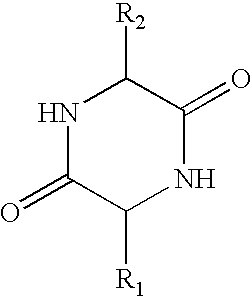Antiperspirant compositions
a technology of antiperspirant compositions and compositions, applied in the direction of disinfection, pharmaceutical delivery mechanisms, toilet preparations, etc., can solve the problems of white marks, visible white deposits, and the polymer exemplified by vu is not a particularly effective structurant for water-immiscible liquids
- Summary
- Abstract
- Description
- Claims
- Application Information
AI Technical Summary
Benefits of technology
Problems solved by technology
Method used
Image
Examples
example 1
In this Example, a stick structured with a cyclodipeptide structurant was made by the following general method.
The RI of the antiperspirant active was measured using a Becke line test, (a standard procedure). In a preliminary determination, the proportion of the carrier oils were calculated and the mixture checked by measurement) such that the refractive index of the mixture was closely matched to that of the active. The cyclo-dipeptide was dissolved in isostearyl alcohol (ISA) whilst being heated to about 125.degree. C. to 135.degree. C., and stirred using an overhead paddle stirrer. The DC 704 was heated to 50.degree. C. whilst being stirred using a stirrer bar. The active was added slowly to the DC704. When all the active had been added, the mixture was sheared using a Silverson mixer at 7000 rpm for 5 minutes. The dispersion of antiperspirant active in the non-volatile silicone oil was heated in an oven at 85.degree. C. The structurant solution in ISA was allowed to cool to 90.d...
example 2
In this Example, the sticks were structured with a combination of a cyclodipeptide and an N-acyl aminoacid amide. The sticks were made by the same general method as for Example 1, except that the structurants were dissolved separately in the ISA component of the carrier liquid mixture, the CDS structurant before GP-1, and the fluid mixture was poured into stick barrels at about 75.degree. C. rather than about 85.degree. C.-90.degree. C.
The composition and properties of the sticks are summarised in Table 3 below.
The sticks containing GP-1 as a co-structurant are harder, but less clear than those formed using the Cyclo Peptides alone. The clarity is however good enough.
example 3
In this Example sticks are made using the same general method as Example 2, but using an N-acyl aminoacid amide as sole structurant. The composition and properties of the sticks are summarised in Table 4 below.
From Table 4, it can be seen after consulting the list of ingredients that both the particle size distribution and the chemical nature of the active are important in determining whether or not the resultant antiperspirant suspension product is clear.
A comparison of Ex3.1 with Comparison C3.1 having formulations that differ in the particle size distribution of the antiperspirant active shows a drop in light transmission from 5.9% which is sufficiently clear to read moderately small letters through the sample to a virtually opaque product in Comparison C3.1. Similarly, a comparison of Example 3.3 with Comparison C3.2 shows a drop in light clarity from 1.8% transmission to virtually nothing. The significant difference between the two formulations resides in the particle size dist...
PUM
| Property | Measurement | Unit |
|---|---|---|
| diameter | aaaaa | aaaaa |
| refractive index | aaaaa | aaaaa |
| refractive index | aaaaa | aaaaa |
Abstract
Description
Claims
Application Information
 Login to View More
Login to View More - R&D
- Intellectual Property
- Life Sciences
- Materials
- Tech Scout
- Unparalleled Data Quality
- Higher Quality Content
- 60% Fewer Hallucinations
Browse by: Latest US Patents, China's latest patents, Technical Efficacy Thesaurus, Application Domain, Technology Topic, Popular Technical Reports.
© 2025 PatSnap. All rights reserved.Legal|Privacy policy|Modern Slavery Act Transparency Statement|Sitemap|About US| Contact US: help@patsnap.com



